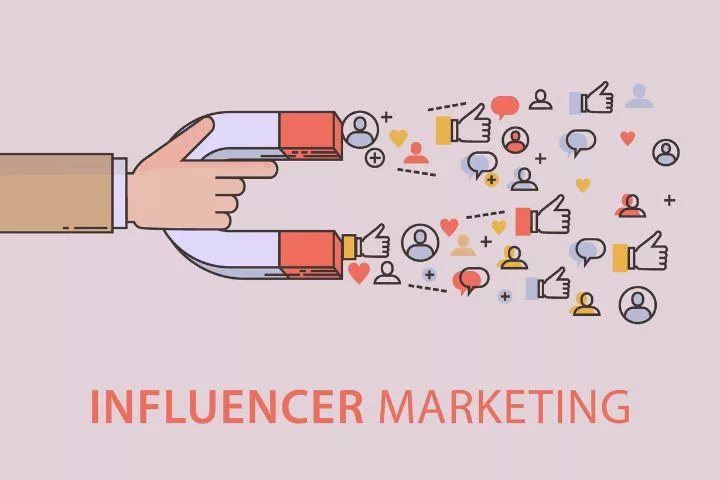Influencer Marketing : The New Form Of Advertising In Social Media

Social media thrive on personal contact. Companies use this as an advertising strategy to reach consumers, for example, with the help of “influencers” via Instagram, YouTube, TikTok, and Co. The boundaries between factual content and advertising are sometimes deliberately blurred. The article enlightens about social media advertising and influencer marketing methods and explains their dangers.
It has been clear for some time that social media are increasingly coming to the fore in everyday life. Users can now hide classic website advertisements by paying attention over time or using technical programs such as “AdBlocker.”
The demand for advertising banners in public spaces is also falling because people use their smartphones instead of noticing advertising.
Advertising needs to be where the consumer’s eyes are, and on the internet, that’s mostly on social media.
Influence Relations: Stars on YouTube and Instagram
YouTube “stars” like Jimmy Donaldson, aka MrBeast, and Nastya are so-called “influencers.” Brands or companies use them to bring their products to potential buyers. This type of advertising is called “Influence Relations”, and is part of influencer marketing.
To be an “influencer,” you have to reach hundreds of thousands or even millions of people with your posts on the Internet platform YouTube or other social media and without direct request, i.e., without directly advertising the product in the usual sense make, lead to the purchase of the product or the use of the service.
The companies pay influencers intending to increase sales i.e, influencer marketing. This is even increased by “cross-promotion.” This is the work of two social media “stars” on a joint post.
By bundling their reach, sales of the product presented in the post increase for the paying company, the “stars” gain in popularity and thus also in “followers” and “likes,” and viewers see their favorite stars together in one post.
In this way, two advertisers transport a message to an attractive target group for both of them.
“Product Placement”: Product advertising with influencers
When companies give influencers the products free of charge or pay them money to rate a particular product according to their own opinion freely, this is called “product placement.”
However, companies are strictly forbidden from influencing the reporting. Product placements are mostly barely recognizable advertisements embedded in the editorial content.
Since the “stars” from social media have become idols for many young people today, and they trust their opinion unconditionally, many viewers buy the same products their role models use.
Surreptitious advertising is prohibited.
The advertising character in such videos is hardly recognizable, so the boundaries between product placement and surreptitious advertising can often not be determined.
Whether the product placement is legal depends on the influencer’s individual marketing of the product. According to the general provisions of competition law and the Interstate Media Treaty, advertising must be recognizable and separated from the rest of the content.
Surreptitious advertising is usually present when the product is not labeled as advertising, and the influencer has received payment or similar consideration to promote sales.
If the product is provided free of charge, it must be determined whether the good or service is of significant value.
Influencers can expect various consequences if there is no corresponding labeling as advertising or influencer marketing .
Surreptitious advertising violates Section 5a Paragraph 6 of the Act Against Unfair Competition (UWG). In these cases, competitors or appropriately qualified associations can sue the influencer for injunctive relief.
A violation of Section 98 in conjunction with Section 8 (7) of the Interstate Media Treaty (MSV) can also be considered. The supervisory authority then threatens to issue prohibition orders.
In addition, the affected influencer violates § 6 of the Telemedia Act (TMG). This violation can also be punished with a fine.
Digital Product Placement: Later built-in advertising
As a result of technical progress, “digital product placement” is now occurring more frequently, i.e., digital product placement.
Advertising for a brand or a company is subsequently integrated into a post and can be changed as desired.
For example, a pop star can pass through a unique clothing store, fast food restaurant, or electronics store in his new music video because this advertising is only integrated afterward.
Native Advertising : Substituted advertising
The term “native advertising” is also used more and more frequently.
Advertising adapts more and more to the context in terms of content and form. It is thus systematically aligned with the editorial content until it can hardly be distinguished from it.
Promoted tweets, Instagram posts, or Facebook posts appearing on the timeline of all social media users, formatted the same as all other posts, are the best example of this.
This advertising is optimally adapted and can only be identified through the small print and subtle marking. As a result, people are sometimes deliberately misled.
Native advertising is also revolutionizing influencer relations. Instead of using YouTube “stars,” bloggers, or other well-known people with a broad reach, companies receive sponsored post on Facebook, Instagram, or Twitter for money, which is liked and commented on by hundreds, thousands, or even millions of people and is free of charge is shared.
For example, if the ad is entertaining, it will be disseminated and shared across all social media. This dissemination costs companies nothing. The users thus become brand ambassadors and advertisers.
Branded Content : Objective only at first glance
With so-called “branded content,” companies create websites that appear objective at first glance to market their products with editorial contributions, videos, etc.
When you look closely at the fine print, you realize that the company whose products are advertised on the site is a sponsor.
Dangers: Lack of objectivity and emotional influence
With the dissolution of the separation between advertising and content, the objectivity of editorial content is disappearing more and more.
Users can no longer make a complete decision between content and advertising or for influencer marketing. They cannot determine to what extent the advertising companies have influenced the range, which could also impair free opinion formation in the future.
In addition, numerous influencers give the impression of a personal connection with the users or followers, which makes them easier to influence.
The consequences of this attachment can be problematic not only in financial terms but also in terms of health. There is increasing evidence of the harmful influence of influencer advertising on the eating habits of young people (including obesity).
Consequences and tips for Internet users
The consequence of “Influence Relations” is that the advertising can no longer be perceived as such and can, therefore, not be subjected to a critical examination by users.
Above all, it will no longer be perceived as disturbing since it will be perfectly integrated into the context and precisely adapted to each individual and the time and place.
Therefore, consumers need to recognize the mechanisms described in the individual situation to continue to separate content (factual information, editorial contributions) and advertising from one another. An emotional bond with influencers should also be critically examined.






